Pubudu N. Pathirana
Federated Learning for Cyber Physical Systems: A Comprehensive Survey
May 08, 2025Abstract:The integration of machine learning (ML) in cyber physical systems (CPS) is a complex task due to the challenges that arise in terms of real-time decision making, safety, reliability, device heterogeneity, and data privacy. There are also open research questions that must be addressed in order to fully realize the potential of ML in CPS. Federated learning (FL), a distributed approach to ML, has become increasingly popular in recent years. It allows models to be trained using data from decentralized sources. This approach has been gaining popularity in the CPS field, as it integrates computer, communication, and physical processes. Therefore, the purpose of this work is to provide a comprehensive analysis of the most recent developments of FL-CPS, including the numerous application areas, system topologies, and algorithms developed in recent years. The paper starts by discussing recent advances in both FL and CPS, followed by their integration. Then, the paper compares the application of FL in CPS with its applications in the internet of things (IoT) in further depth to show their connections and distinctions. Furthermore, the article scrutinizes how FL is utilized in critical CPS applications, e.g., intelligent transportation systems, cybersecurity services, smart cities, and smart healthcare solutions. The study also includes critical insights and lessons learned from various FL-CPS implementations. The paper's concluding section delves into significant concerns and suggests avenues for further research in this fast-paced and dynamic era.
Quantum-Inspired Genetic Algorithm for Robust Source Separation in Smart City Acoustics
Apr 10, 2025Abstract:The cacophony of urban sounds presents a significant challenge for smart city applications that rely on accurate acoustic scene analysis. Effectively analyzing these complex soundscapes, often characterized by overlapping sound sources, diverse acoustic events, and unpredictable noise levels, requires precise source separation. This task becomes more complicated when only limited training data is available. This paper introduces a novel Quantum-Inspired Genetic Algorithm (p-QIGA) for source separation, drawing inspiration from quantum information theory to enhance acoustic scene analysis in smart cities. By leveraging quantum superposition for efficient solution space exploration and entanglement to handle correlated sources, p-QIGA achieves robust separation even with limited data. These quantum-inspired concepts are integrated into a genetic algorithm framework to optimize source separation parameters. The effectiveness of our approach is demonstrated on two datasets: the TAU Urban Acoustic Scenes 2020 Mobile dataset, representing typical urban soundscapes, and the Silent Cities dataset, capturing quieter urban environments during the COVID-19 pandemic. Experimental results show that the p-QIGA achieves accuracy comparable to state-of-the-art methods while exhibiting superior resilience to noise and limited training data, achieving up to 8.2 dB signal-to-distortion ratio (SDR) in noisy environments and outperforming baseline methods by up to 2 dB with only 10% of the training data. This research highlights the potential of p-QIGA to advance acoustic signal processing in smart cities, particularly for noise pollution monitoring and acoustic surveillance.
Enhancing Federated Learning Through Secure Cluster-Weighted Client Aggregation
Mar 29, 2025Abstract:Federated learning (FL) has emerged as a promising paradigm in machine learning, enabling collaborative model training across decentralized devices without the need for raw data sharing. In FL, a global model is trained iteratively on local datasets residing on individual devices, each contributing to the model's improvement. However, the heterogeneous nature of these local datasets, stemming from diverse user behaviours, device capabilities, and data distributions, poses a significant challenge. The inherent heterogeneity in federated learning gives rise to various issues, including model performance discrepancies, convergence challenges, and potential privacy concerns. As the global model progresses through rounds of training, the disparities in local data quality and quantity can impede the overall effectiveness of federated learning systems. Moreover, maintaining fairness and privacy across diverse user groups becomes a paramount concern. To address this issue, this paper introduces a novel FL framework, ClusterGuardFL, that employs dissimilarity scores, k-means clustering, and reconciliation confidence scores to dynamically assign weights to client updates. The dissimilarity scores between global and local models guide the formation of clusters, with cluster size influencing the weight allocation. Within each cluster, a reconciliation confidence score is calculated for individual data points, and a softmax layer generates customized weights for clients. These weights are utilized in the aggregation process, enhancing the model's robustness and privacy. Experimental results demonstrate the efficacy of the proposed approach in achieving improved model performance in diverse datasets.
Adaptive Clipping for Privacy-Preserving Few-Shot Learning: Enhancing Generalization with Limited Data
Mar 27, 2025Abstract:In the era of data-driven machine-learning applications, privacy concerns and the scarcity of labeled data have become paramount challenges. These challenges are particularly pronounced in the domain of few-shot learning, where the ability to learn from limited labeled data is crucial. Privacy-preserving few-shot learning algorithms have emerged as a promising solution to address such pronounced challenges. However, it is well-known that privacy-preserving techniques often lead to a drop in utility due to the fundamental trade-off between data privacy and model performance. To enhance the utility of privacy-preserving few-shot learning methods, we introduce a novel approach called Meta-Clip. This technique is specifically designed for meta-learning algorithms, including Differentially Private (DP) model-agnostic meta-learning, DP-Reptile, and DP-MetaSGD algorithms, with the objective of balancing data privacy preservation with learning capacity maximization. By dynamically adjusting clipping thresholds during the training process, our Adaptive Clipping method provides fine-grained control over the disclosure of sensitive information, mitigating overfitting on small datasets and significantly improving the generalization performance of meta-learning models. Through comprehensive experiments on diverse benchmark datasets, we demonstrate the effectiveness of our approach in minimizing utility degradation, showcasing a superior privacy-utility trade-off compared to existing privacy-preserving techniques. The adoption of Adaptive Clipping represents a substantial step forward in the field of privacy-preserving few-shot learning, empowering the development of secure and accurate models for real-world applications, especially in scenarios where there are limited data availability.
Multi-Objective Optimization for Privacy-Utility Balance in Differentially Private Federated Learning
Mar 27, 2025Abstract:Federated learning (FL) enables collaborative model training across distributed clients without sharing raw data, making it a promising approach for privacy-preserving machine learning. However, ensuring differential privacy (DP) in FL presents challenges due to the trade-off between model utility and privacy protection. Clipping gradients before aggregation is a common strategy to limit privacy loss, but selecting an optimal clipping norm is non-trivial, as excessively high values compromise privacy, while overly restrictive clipping degrades model performance. In this work, we propose an adaptive clipping mechanism that dynamically adjusts the clipping norm using a multi-objective optimization framework. By integrating privacy and utility considerations into the optimization objective, our approach balances privacy preservation with model accuracy. We theoretically analyze the convergence properties of our method and demonstrate its effectiveness through extensive experiments on MNIST, Fashion-MNIST, and CIFAR-10 datasets. Our results show that adaptive clipping consistently outperforms fixed-clipping baselines, achieving improved accuracy under the same privacy constraints. This work highlights the potential of dynamic clipping strategies to enhance privacy-utility trade-offs in differentially private federated learning.
Quantum-Enhanced Transformers for Robust Acoustic Scene Classification in IoT Environments
Jan 16, 2025Abstract:The proliferation of Internet of Things (IoT) devices equipped with acoustic sensors necessitates robust acoustic scene classification (ASC) capabilities, even in noisy and data-limited environments. Traditional machine learning methods often struggle to generalize effectively under such conditions. To address this, we introduce Q-ASC, a novel Quantum-Inspired Acoustic Scene Classifier that leverages the power of quantum-inspired transformers. By integrating quantum concepts like superposition and entanglement, Q-ASC achieves superior feature learning and enhanced noise resilience compared to classical models. Furthermore, we introduce a Quantum Variational Autoencoder (QVAE) based data augmentation technique to mitigate the challenge of limited labeled data in IoT deployments. Extensive evaluations on the Tampere University of Technology (TUT) Acoustic Scenes 2016 benchmark dataset demonstrate that Q-ASC achieves remarkable accuracy between 68.3% and 88.5% under challenging conditions, outperforming state-of-the-art methods by over 5% in the best case. This research paves the way for deploying intelligent acoustic sensing in IoT networks, with potential applications in smart homes, industrial monitoring, and environmental surveillance, even in adverse acoustic environments.
VR Based Emotion Recognition Using Deep Multimodal Fusion With Biosignals Across Multiple Anatomical Domains
Dec 03, 2024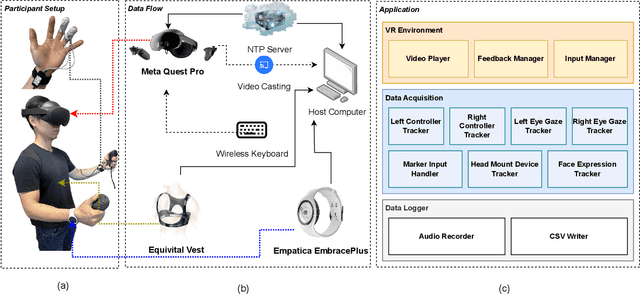
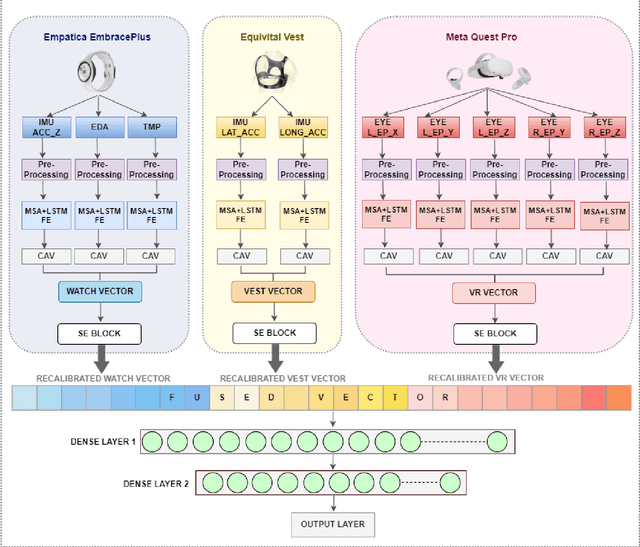
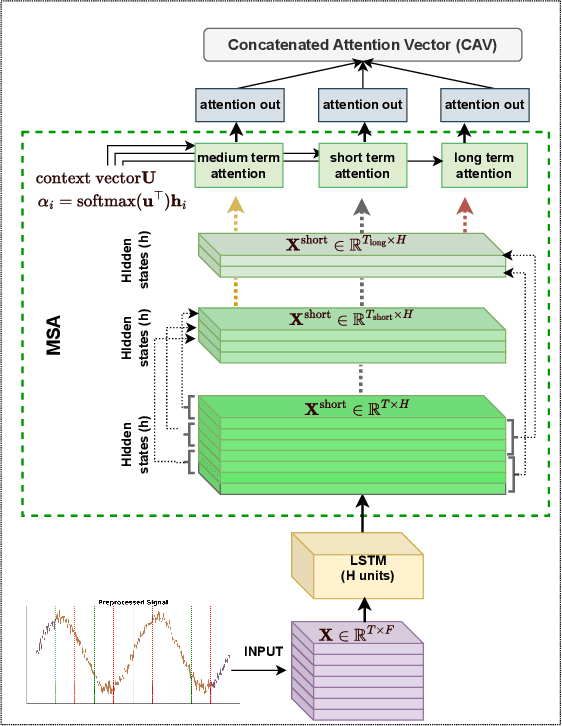

Abstract:Emotion recognition is significantly enhanced by integrating multimodal biosignals and IMU data from multiple domains. In this paper, we introduce a novel multi-scale attention-based LSTM architecture, combined with Squeeze-and-Excitation (SE) blocks, by leveraging multi-domain signals from the head (Meta Quest Pro VR headset), trunk (Equivital Vest), and peripheral (Empatica Embrace Plus) during affect elicitation via visual stimuli. Signals from 23 participants were recorded, alongside self-assessed valence and arousal ratings after each stimulus. LSTM layers extract features from each modality, while multi-scale attention captures fine-grained temporal dependencies, and SE blocks recalibrate feature importance prior to classification. We assess which domain's signals carry the most distinctive emotional information during VR experiences, identifying key biosignals contributing to emotion detection. The proposed architecture, validated in a user study, demonstrates superior performance in classifying valance and arousal level (high / low), showcasing the efficacy of multi-domain and multi-modal fusion with biosignals (e.g., TEMP, EDA) with IMU data (e.g., accelerometer) for emotion recognition in real-world applications.
HierSFL: Local Differential Privacy-aided Split Federated Learning in Mobile Edge Computing
Jan 16, 2024Abstract:Federated Learning is a promising approach for learning from user data while preserving data privacy. However, the high requirements of the model training process make it difficult for clients with limited memory or bandwidth to participate. To tackle this problem, Split Federated Learning is utilized, where clients upload their intermediate model training outcomes to a cloud server for collaborative server-client model training. This methodology facilitates resource-constrained clients' participation in model training but also increases the training time and communication overhead. To overcome these limitations, we propose a novel algorithm, called Hierarchical Split Federated Learning (HierSFL), that amalgamates models at the edge and cloud phases, presenting qualitative directives for determining the best aggregation timeframes to reduce computation and communication expenses. By implementing local differential privacy at the client and edge server levels, we enhance privacy during local model parameter updates. Our experiments using CIFAR-10 and MNIST datasets show that HierSFL outperforms standard FL approaches with better training accuracy, training time, and communication-computing trade-offs. HierSFL offers a promising solution to mobile edge computing's challenges, ultimately leading to faster content delivery and improved mobile service quality.
Holistic Survey of Privacy and Fairness in Machine Learning
Jul 28, 2023Abstract:Privacy and fairness are two crucial pillars of responsible Artificial Intelligence (AI) and trustworthy Machine Learning (ML). Each objective has been independently studied in the literature with the aim of reducing utility loss in achieving them. Despite the significant interest attracted from both academia and industry, there remains an immediate demand for more in-depth research to unravel how these two objectives can be simultaneously integrated into ML models. As opposed to well-accepted trade-offs, i.e., privacy-utility and fairness-utility, the interrelation between privacy and fairness is not well-understood. While some works suggest a trade-off between the two objective functions, there are others that demonstrate the alignment of these functions in certain scenarios. To fill this research gap, we provide a thorough review of privacy and fairness in ML, including supervised, unsupervised, semi-supervised, and reinforcement learning. After examining and consolidating the literature on both objectives, we present a holistic survey on the impact of privacy on fairness, the impact of fairness on privacy, existing architectures, their interaction in application domains, and algorithms that aim to achieve both objectives while minimizing the utility sacrificed. Finally, we identify research challenges in achieving privacy and fairness concurrently in ML, particularly focusing on large language models.
Intelligent Blockchain-based Edge Computing via Deep Reinforcement Learning: Solutions and Challenges
Jun 17, 2022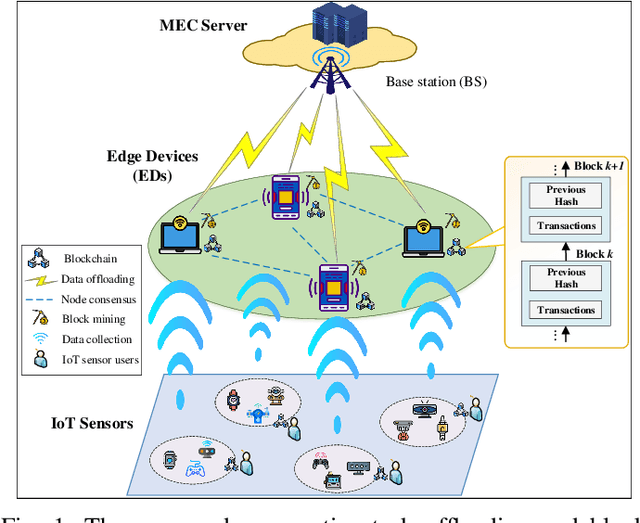
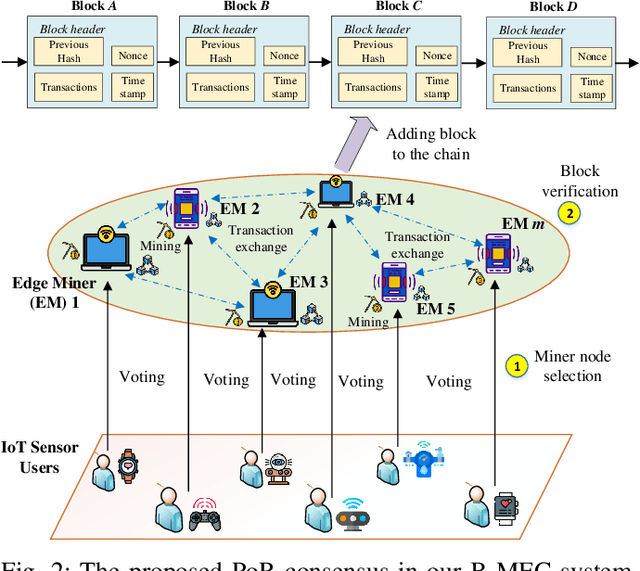
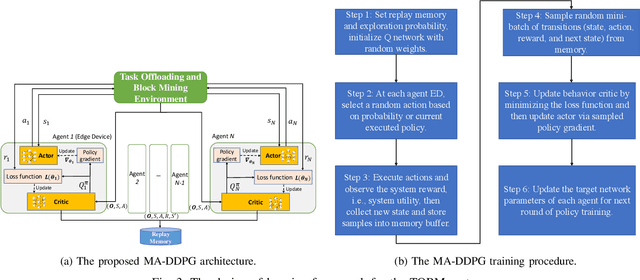

Abstract:The convergence of mobile edge computing (MEC) and blockchain is transforming the current computing services in wireless Internet-of-Things networks, by enabling task offloading with security enhancement based on blockchain mining. Yet the existing approaches for these enabling technologies are isolated, providing only tailored solutions for specific services and scenarios. To fill this gap, we propose a novel cooperative task offloading and blockchain mining (TOBM) scheme for a blockchain-based MEC system, where each edge device not only handles computation tasks but also deals with block mining for improving system utility. To address the latency issues caused by the blockchain operation in MEC, we develop a new Proof-of-Reputation consensus mechanism based on a lightweight block verification strategy. To accommodate the highly dynamic environment and high-dimensional system state space, we apply a novel distributed deep reinforcement learning-based approach by using a multi-agent deep deterministic policy gradient algorithm. Experimental results demonstrate the superior performance of the proposed TOBM scheme in terms of enhanced system reward, improved offloading utility with lower blockchain mining latency, and better system utility, compared to the existing cooperative and non-cooperative schemes. The paper concludes with key technical challenges and possible directions for future blockchain-based MEC research.
 Add to Chrome
Add to Chrome Add to Firefox
Add to Firefox Add to Edge
Add to Edge